The Way of the Sword
The martial arts of Kendo and Iaido are distinctly Japanese and a part of Japan’s rich culture. Kendo has worldwide recognition. Many high schools in Japan have Kendo clubs, as it is very popular. As of March 2021, there were 1,972,002 dan-grade Kendoka’s in Japan. Iaido on the other hand is much less popular and less well-known, even here.
I studied Kendo for a few years when I was younger in the UK and for a short time in Japan. I’ve also studied Iaido for around 10 years in the UK and Japan. Here’s a brief introduction to both, and some similarities/differences between them.
Kendo: History
Kendo originated from the experiences of the samurai who trained to use nihonto (Japanese swords) in combat. It is believed that through studying kendo, you are able to gain an understanding of the “principles of the sword”.
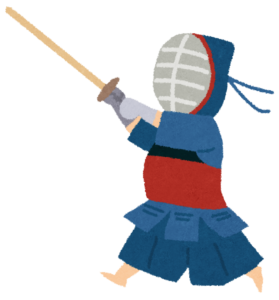 Before Kendo was developed, kenjutsu (swordsmanship) was studied. In the 18th century, protective training armor resembling that used in Kendo today was developed. Training using shinai (bamboo swords) also took root. Consequently, a competitive style of kenjutsu competition gained popularity and spread throughout the country around the end of the Edo period.
Before Kendo was developed, kenjutsu (swordsmanship) was studied. In the 18th century, protective training armor resembling that used in Kendo today was developed. Training using shinai (bamboo swords) also took root. Consequently, a competitive style of kenjutsu competition gained popularity and spread throughout the country around the end of the Edo period.
Early in the 20th century, this type of training- gekiken or kenjutsu- was renamed “kendo” which literally means the “Way of the sword”. Kendo became a representative discipline of modern Japanese budo (martial arts/ways). In these, the underpinning ideals of self-improvement are grounded in the spirit of the samurai.
Kendo: Training
The training is usually broken up in to 2 parts. The first part of the lesson focuses on waza (techniques) and kata (set forms), and they are studied and drilled. Then 2nd part of the lesson focuses on Ji-geiko (free sparring).
Kendo can be very physically demanding as the training is very intense. Kendo training is designed to push you to your physical limits so that you can overcome them. It’s common to get lots of minor injuries when training, mostly muscle sprains and blisters on your feet. But although the training looks very dangerous, the risk of major injury is very low as the armor is very strong.
What do you need to study Kendo?
All kendoka wear hakama (Japanese traditional trousers) and kendogi, a thick training top. The hakama can easily get creased if not folded and stored correctly. Maintaining your equipment is as much a part of Kendo as is the training. The cost for these go from reasonably cheap to very expensive depending on the material and brand.
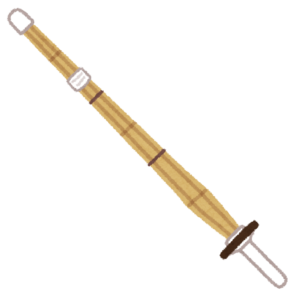 Also, you need a shinai (bamboo training sword) and sometimes a bokken (wooden sword). These aren’t too expensive and reasonably priced ones can be easily bought in Japan. Lastly, there’s the bogu (Kendo armor). This is the expensive part of studying Kendo, as even a cheap set costs around about ¥30,000.
Also, you need a shinai (bamboo training sword) and sometimes a bokken (wooden sword). These aren’t too expensive and reasonably priced ones can be easily bought in Japan. Lastly, there’s the bogu (Kendo armor). This is the expensive part of studying Kendo, as even a cheap set costs around about ¥30,000.
Machine-stitched bogu is the cheapest, and the price goes up the closer the stitches are together. This is measured in BU in Japan. Hand-stitched bogu with a 1.2 BU (very close) is extremely expensive. Bogu with close stitches means it will last the rigors of training longer.
A word of advice: you get very sweaty while training and after a while the armor can get very smelly if you don’t air it fully after use. When I first started Kendo I used the club armor and after I took it off I noticed the horrible smell it left. So the very next day I went and bought my own set of bogu. Using shared bogu is horrible as its usually old and pungent. So if you’re serious about Kendo, make sure to purchase a new set and take good care of it.
Iaido: History
Iaido is much older than Kendo and originated from the original kenjutsu schools. There are several Koryū schools of Iai (Koryū are schools of martial arts that originated in Japan, and were founded prior to 1876). The most well known is Kashima Shintō-ryū (鹿島新当流) founded by Tsukahara Bokuden in the Muromachi period (c.1530). Iaido was formed during the tumultuous Sengoku Jidai, a time of feudal war. The school’s techniques are based on battlefield experience. They also revolve around finding weak points in the opponent’s armor.
 There are many different styles of Iaido; some are old and some more modern. Iai training compared to Kendo is much less demanding physically, but more mentally. A typical Iaido lesson consists of learning and practicing kata, both by yourself and in pairs as you get more advanced. Great emphasis is placed in paying attention to each movement within the kata and self analyzing to see what you did wrong.
There are many different styles of Iaido; some are old and some more modern. Iai training compared to Kendo is much less demanding physically, but more mentally. A typical Iaido lesson consists of learning and practicing kata, both by yourself and in pairs as you get more advanced. Great emphasis is placed in paying attention to each movement within the kata and self analyzing to see what you did wrong.
A few schools study tameshigiri (test cutting) of tatami (reed mats rolled up) or bamboo targets, although the majority don’t.
What do you need to study Iaido?
Like Kendo, hakama (trousers) and gi (top) is worn, although the Iai version is usually thinner than the kendo ones. At first training is done mostly with bokken (wooden sword) and these can be obtain relatively cheaply in Japan.
As you advance in skill you start to use a Iaito (blunt metal training sword). These start from around ¥30,000. They can go up in price considerably depending on the maker and fittings used on the sword. And then on to Nihonto: the majority of Iaidoka don’t own one, but if you want to buy one they are extremely expensive and you have to register it with the police.
In Conclusion
I highly recommend studying either Kendo or Iaido. You will learn not only a martial art, but also gain a greater understanding of Japanese culture. In particular, great emphasis is placed on etiquette and politeness in the training. These really are useful for getting a better understanding of the Japanese mindset. Awaken your own warrior’s heart, and learn a little more about Japan in the process!
Further Information
For further info check out https://www.kendo.or.jp/en/knowledge/ If you want to find out more about kendo near you, then check out the All Japan Kendo Federation to find a dojo https://www.kendo.or.jp/en/knowledge/kendo-origin/
For those in Tokyo, I recommend Tokyo Kyumeikan Dojo in Akatsuka. They are very friendly and several of the instructors speak English. http://www.bekkoame.ne.jp/~kyumeikan/homenglish.htm
If you live near Yokohama I thoroughly recommend that you check out https://www.ibf-battodo.org/ This is the main dojo for the International Battodo Federation and they are very friendly and welcoming to foreigners.
Photo Credits:
Other images courtesy of Irasutoya
All other content (text) created by the original author and © 2022 MUSUBI by Borderlink
Top Photo: Alexei_other via Pixabay
Japan’s own intercultural communities: Food
In light of the recent COVID-19 pandemic, many of us have found ourselves in a situation where international travel is difficult and even discouraged. But if one looked closely, there are many places in Japan with a high percentage of foreign nationals converge.
In those communities, one may enjoy the feeling of being in a different country, even if it`s just outside the main cities. We’ve written before about the best Indian food in Yamanashi. Here are some places in Kanto that offer such excitement.
Oizumi (Gunma)
Oizumi (大泉町), situated south of the city of Ota, is a well-known Brazilian community in the Kanto region. Initially settled by the Brazilian workers employed at the nearby Subaru factory, Oizumi has become a thriving hub of Brazilian expatriates and Latin Americans in general.
Upon disembarking the train at Nishikoizumi (西小泉), visitors will immediately notice a façade of signs written in Portuguese. The best places to visit are scattered around the station.
However, “Super Mercado Takara” is a recommended first stop. The store offers most of the imported products available in the town, and the restaurant offers Brazilian delicacies such as the famous churrasco. Also, the bakery near the store offers authentic Brazilian breads such as the pao de queijo.
Access: 1 hour 30 minutes from the Asakusa Station on the Tobu Railroad.
Nishikawaguchi (Saitama)
Looking for a distinctively Chinese atmosphere? Forget Chinatown. Nishi-Kawaguchi (西川口) is the place to go. Originally notorious as a red light district, Nishi-Kawaguchi is now home to a heavy concentration of Chinese and other Asian expatriates.
Upon exiting the station, one may see a flood of Chinese and Vietnamese-owned businesses and restaurants. The personal favorite of mine is the Lanzhou Beef Noodles. Developed by the Chinese Muslims, it offers halal alternatives to Japanese ramen, which often uses pork.
There are as many as three restaurants serving this delicacy (though more are expected to open in the future), but the one closest to the station is a restaurant called the “Togyu” (唐牛).
As with all the other restaurants, the noodles are custom-made by hand upon ordering. Also, one may choose other options such as the amount of cilantro and how spicy do you want your bowl to be. One piece of advice is that Japanese is almost never used, and you might need help ordering by a tablet, which is all in Chinese.
Access: 20 minutes from Ueno on Keihin-Tohoku Line
There are just some of the examples of foreign communities in Japan. But there’s almost always an expat community in the major cities. There, one may easily experience being in a different country all within the confines of being in Japan. So next time you feel like traveling, why don’t you try going abroad locally?
Photo Credits
Top Photo: Alexei_other via Pixabay
All other content (text) created by the original author and © 2022 MUSUBI by Borderlink
Top Photo: melody111さん via PhotoAC
Ashikaga is a city that is located north of Tokyo in Tochigi Prefecture. It takes about 2 hours or so to get there from Tokyo. In the past, this place was known for its education, and has Japan’s oldest school still standing as of 2022. Today, Ashikaga is best known to tourists for a few other places.
Ashikaga Flower Park
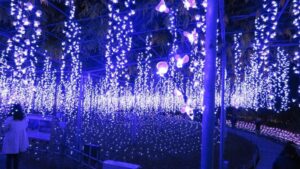 Ashikaga Flower Park is the biggest draw to this city today. The park goes through 8 different floral seasons throughout the year, meaning there’s always a new set of flower displays to see. Each season spans about 1 & 1/2 to 2 months. Of course, the most popular time to go is during the spring season, especially during the time when the wisteria bloom. Wisteria bloom around mid-April to mid-May. The oldest and largest wisteria in Japan is at this park.
Ashikaga Flower Park is the biggest draw to this city today. The park goes through 8 different floral seasons throughout the year, meaning there’s always a new set of flower displays to see. Each season spans about 1 & 1/2 to 2 months. Of course, the most popular time to go is during the spring season, especially during the time when the wisteria bloom. Wisteria bloom around mid-April to mid-May. The oldest and largest wisteria in Japan is at this park.
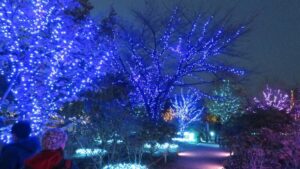 But there is another season that has been becoming more popular recently. During the end of October to late January, the park puts up a beautiful display of lights around the park. If you love looking at all the amazing winter illuminations around Japan, this is definitely a place not to miss. You can see the lights around the park set up as if they were the different plants throughout the year.
But there is another season that has been becoming more popular recently. During the end of October to late January, the park puts up a beautiful display of lights around the park. If you love looking at all the amazing winter illuminations around Japan, this is definitely a place not to miss. You can see the lights around the park set up as if they were the different plants throughout the year.
Orihime Shrine
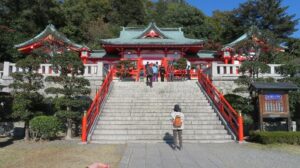 Another notable place in Ashikaga is its Orihime Shrine. If you are familiar with the story of Tanabata, this is the Orihime from that story. Tanabata is also a love story, although a little tragic. It is between a princess who weaved clothes for her father and a herder named Hikoboshi. As textiles are a big part of Ashikaga, they built this shrine is dedication to the princess. This shrine is also popular for marriage since the story focuses on two lovers.
Another notable place in Ashikaga is its Orihime Shrine. If you are familiar with the story of Tanabata, this is the Orihime from that story. Tanabata is also a love story, although a little tragic. It is between a princess who weaved clothes for her father and a herder named Hikoboshi. As textiles are a big part of Ashikaga, they built this shrine is dedication to the princess. This shrine is also popular for marriage since the story focuses on two lovers.
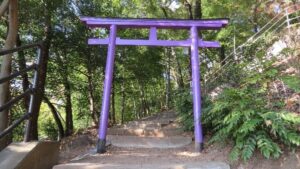 At the entrance there is two paths. Behind the main torii gate is a steep set of stairs totaling about 229 steps. It is said that if you climb up this path, you wish will come true. At the top of the stairway path is the main building known as Oka no Ryugujo which is said to be modeled after the famous Phoenix Hall in Kyoto. On the way down, it is recommended to take the less steep path though the 7 colored torii gates. Exiting through these will ensure luck and positive links to people, health, knowledge, life, studies, work, and management. The different colors are orange, blue, yellow, green, purple, light green, and red.
At the entrance there is two paths. Behind the main torii gate is a steep set of stairs totaling about 229 steps. It is said that if you climb up this path, you wish will come true. At the top of the stairway path is the main building known as Oka no Ryugujo which is said to be modeled after the famous Phoenix Hall in Kyoto. On the way down, it is recommended to take the less steep path though the 7 colored torii gates. Exiting through these will ensure luck and positive links to people, health, knowledge, life, studies, work, and management. The different colors are orange, blue, yellow, green, purple, light green, and red.
Conclusion
Although Ashikaga is a decent trip from Tokyo, it is still easy to get there using available train lines. And best of all, there is so much more to see there then just these two places. There are many other shrines and temples, as well as the oldest school in Japan. Even the walk to these places feels calm and refreshing, just admiring the scenery and the city itself. It’s also a great place to pair with for a weekend trip to Utsunomiya! So, if you feel like adventuring outside of Tokyo and you want to see a place with a lot of beauty, please visit Ashikaga.
You can visit Ashikaga. Or you can live there! Find out more about being an Assistant Language Teacher today!
Photo Credits:
Top Photo: melody111さん via PhotoAC
Previous Version: Raita Futo / CC BY 2.0
All other images were provided by the original author and are Ⓒ MUSUBI by Borderlink
Top Image: Atikah Akhtar on Unsplash
And now, thoughts on the dentists and dental care system of Japan… from a licensed dentist!
Wait, it costs how much?
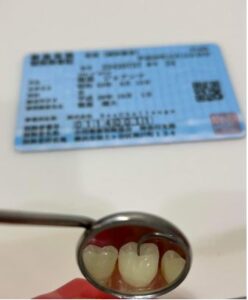 Japan introduced a universal health insurance system for the entire population in 1961. People are able to receive treatment at a relatively low cost. This National Health Insurance covers a wide range of medical treatments, and patients bear only 30% of their medical costs.
Japan introduced a universal health insurance system for the entire population in 1961. People are able to receive treatment at a relatively low cost. This National Health Insurance covers a wide range of medical treatments, and patients bear only 30% of their medical costs.
The brightest side of this system is that general dental treatments are also covered. Looking to get your teeth cleaned? Covered! Need a filling? Covered! How about a crown? Well, mostly covered!
Mostly?
There are some dental treatments that are 70% covered by Japan’s National Health Insurance, but with some conditions. A crown for your front teeth is possible, but only using plastic & fused metal. Crowns for molar teeth on the other hand use silver metal crowns only. Root Canal Treatment is possible, but it will require at least four visits or more.
In layman’s terms, you can get good dental treatment on National Health Insurance, but not the best. Your crowns won’t be the most natural-looking and you may need to get them replaced in a few decades. But in general the quality is quite good.
Why does Japan have so many dentists?
My first 6 months staying in Japan, I noticed there seem to be more dental clinics than convenience stores in Japan. Dentistry has a reputation as being a profitable and easy-to-maintain business. Demand for good dental hygiene has been growing in Japan, so more students are drawn to the profession to help people keep their pearly whites.
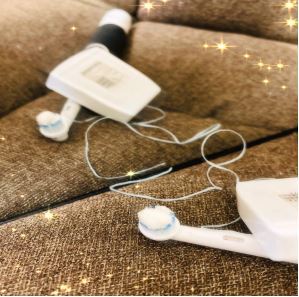 I have great admiration and respect for English-speaking dentists. More and more, foreign patients who can’t speak Japanese need help. Perhaps I should say they can’t speak Dental Japanese: the terms and phrases associated with dental hygiene and care. It’s frustrating when we can’t understand what the dentist is saying.
I have great admiration and respect for English-speaking dentists. More and more, foreign patients who can’t speak Japanese need help. Perhaps I should say they can’t speak Dental Japanese: the terms and phrases associated with dental hygiene and care. It’s frustrating when we can’t understand what the dentist is saying.
So it’s helpful to have more and more bilingual dentists (or at least, dentists that give it their best shot). Even if your local dentist has limited English though, fret not. Stick to the appointment, show up on time, and let them do their job. I’ll go over some basic terms in a moment, but it’s really not that difficult. Don’t be afraid of visiting the dentist in Japan if you haven’t before!
Useful dentistry-related Japanese words
Shikaiin ( ⻭科医院 ) Dental Clinic
Shikaeiseishi ( ⻭科衛⽣⼠) Dental Hygienist
Haisha ( ⻭医者 ) Dentist
Shikajoshu ( ⻭科助⼿) Dental Assistant
Ha ( ⻭ ) Tooth
Nyushi ( 乳⻭) Baby Teeth
Eikyushi (永久⻭ ) Permanent Teeth
Haguki ( ⻭茎) Gums
Maeba ( 前⻭ ) Front tooth
Okuba ( 奥⻭) Back Tooth
Ueno ha ( 上の⻭ ) Upper Tooth
Shita no ha ( 下の⻭) Lower Tooth
Oyashirazu ( 親知らず ) Wisdom Tooth
Shinkei (神経) Dental Nerve
Shinsatsu ( 診察 ) Have a Check-Up
Ha no itami ( ⻭の痛み) Toothache
Chikakukabin ( 知覚過敏 ) Sensitive Tooth
Shiko ( ⻭垢) Plaque
Hanokibami ( ⻭の⻩ばみ ) Stain
Mushiba ( ⾍⻭) Cavity
Ginba ( 銀⻭ ) Silver-crowed Tooth
Tsumemono ( 詰め物) Filling
Ireba (⼊れ⻭ )Denture
Rentogen ( レントゲン) X-ray
Basshi ( 抜⻭ ) Tooth Extraction
Chiryo ( 治療 ) Treatment
Lastly, some tips for home dental care
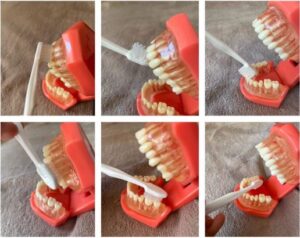 Here’s some advice you’ll get at any dentist in Japan (or otherwise!)
Here’s some advice you’ll get at any dentist in Japan (or otherwise!)
1. Take your soft bristle toothbrush, hold it at a 45 degree angle to your teeth, whether it’s the front teeth or back teeth.
2. Brush gently up and down. Do not scrub roughly, as this causes the thin gum tissue to wear down.
3. Don’t be quick when you brush your teeth. Take at least 2 minutes. Look in the mirror and make sure you cover every area.
4. You may not realize this, but brushing your tongue is good as well! As many germs and bacteria can collect there, it’s always good to give it a light scrub. Especially before bed time.
5. Gently floss between your teeth using a back-and-forth motion. Use your index fingers to direct the floss between the teeth.
6. Lastly, don’t forget to occasionally refresh your best weapons to prevent cavities: plaque-fighting toothpaste, a soft bristle toothbrush, and floss. Especially the toothbrush; you should swap it out regularly.
As George Taylor said, “poor oral health care can result in poor overall health.” Make sure to visit your dentist every two-three months for regular cleaning and check-ups. And don’t forget to brush!
Photo Credits:
Top Image: Atikah Akhtar on Unsplash
Additional photos provided by Jhoanna Fukuya
All other content (text) created by the original author and © 2022 MUSUBI by Borderlink
Top photo: “宇都宮市街地遠景” by シンプルですけど機能的なベッド , licensed under the Creative Commons Attribution-Share Alike 4.0 International license (CC BY-SA 4.0) No changes or modifications made. Wikimedia Commons Link
Yes, you read it right! A cliché title. But wait, where is Tochigi?
Tochigi Prefecture is a popular tourist destination located approximately 100 km north of Tokyo and is easily accessible by multiple train lines. You’ll be surrounded by nature after just a 50-minute Shinkansen ride or 90-minute drive from Tokyo.
I’ve been living in Tochigi for almost 10 years, but even now I haven’t been everywhere. To list all the things to do and places to visit Tochigi would take a while. Well, here’s a start! But for this article I decided to narrow it down to one city in particular. Here’s my Top 5 things to do in Utsunomiya, the commercial heart of Tochigi. Let’s take it away!
1. Eat at the famous gyoza shop Utsunomiya Minmin
Gyoza (餃子) are Chinese-style dumplings (Jiaozi) and a popular food in across Japan. They are also one of Utsunomiya’s local specialities. The dumpling specialty store Utsunomiya Minmin, opened in 1958, is a restaurant committed to these dumplings. It serves three most popular varieties—grilled, fried and served in soup.
2. Have some fun at Tochinoki Family Land
The Tochinoki Family Land is an amusement park for children located inside the Tochigi Sports Park. Entrance is free. The park is packed with attractions. These include a thrilling rollercoaster designed to look like the E5 model Hayabusa Bullet Train. There’s also the the sky ship, merry-go-round, and a big Ferris wheel. On weekends there are shows and street performers, and many more events throughout the year.
3. Come see the Utsunomiya Zoo
This zoo in Utsunomiya City, Tochigi Prefecture has a theme of “Nature, Animals, and Kids.” You can see the animals up-close and feed some of the smaller ones at the petting zoo. Pony rides are popular with the kids. There is also an amusement park on the grounds, a pool that’s open in summer, and a winter fishing pond.
4. Pay a visit to the Utsunomiya Futaarayama Shrine
Many citizens come to the shrine on special occasions such as New Year and Shichi-Go-San (the “7-5-3” celebration of children’s growth). The illuminated gate and approach to the shrine are an incredible evening sight. The shrine is also home to some important national works of art.
5. Relax in the Hachimanyama Park
This park located in the center of Utsunomiya City. It has numerous attractions including Utsunomiya Tower, which offers a sweeping view of the city, Adventure U playground, which features a large playground and go-kart track, a zoo, and more.
Some 800 cherry blossoms trees and 700 azalea bushes have been planted in the park, making it a well-known destination for flower viewing. During the flower-viewing season, the park is illuminated with paper lanterns, Utsunomiya Tower is lit up, and vendors set up festival stalls in the park.
So you’ve got a place to eat, a place to play with the kids, and nice sightseeing places. But where can you buy some souvenirs? None other than the famous Don Quijote. This Mega “Donki” is 5 stories high so whatever you’re looking for, I’m sure it’s in here!
I hope this article gave you a little insight into the many fun places you can visit up here in Utsunomiya. It’s not be the first city anyone thinks of visiting. But as a stopgap between Tokyo and Sendai, you can’t go wrong with the big U!
Photo Credits:
Top photo: “宇都宮市街地遠景” by シンプルですけど機能的なベッド , licensed under the Creative Commons Attribution-Share Alike 4.0 International license (CC BY-SA 4.0) No changes or modifications made. Wikimedia Commons Link
All other content (text) created by the original author and © 2022 MUSUBI by Borderlink
Top Image: @felipepelaquim on Unsplash
Ahhh… kanji, the bane, and goal, of many foreigners living in Japan. I will be honest with you, I have only been studying kanji for about a year or two. And it is HARD! But don’t let that discourage you. It is said that by the end of high school, the average student knows about 2,000 kanji characters, and these should be enough for them to read an average newspaper. In this article, I will try to guide you to the 5 kanji you should definitely learn. But first, a little background…
What the Heck is a Logograph?
Kanji was developed a long time ago by some smart Chinese guys who gave it to some smart Japanese guys. Too vague? Ok, so Kanji was created roughly 3,300 years ago in China during the Shang Dynasty.
Fast forward a couple thousand years to about the fourth of fifth century when China decided to communicate with Japan. At that time, Japan had no standardized writing system. They decided to “borrow” the Chinese writing system and fit it to the Japanese pronunciation. Logographic writing system basically means that there are symbols that stand for words and/or morpheme (the smallest meaningful item in a language- sometimes being a root word in English). Simple enough, right?
With that out of the way, here are the 5 kanji you should know if you want to live in Japan, starting with number…
5. 円
This one is pretty easy to learn because most people see it on a daily basis. This is the kanji for Yen (or pronounced [‘en] sometimes), the Japanese currency. It is so common that even people who swear they don’t know kanji are able to recognize the symbol. It becomes almost a subconscious learning experience.
4. お手洗い
This is pronounced [ o te ara i ] and it is important because it is what it (kind of) sounds like, the toilet. People will often write the katakana next to it (トイレ), but I believe you should learn it, just to be safe. After all, it is better to know it and not need it, than to need it and not know it!
3. a. 女 b.男
(This one is a twofer (two for the price of one), because it ties in nicely with number 4.) The first kanji means female [ onna ] and as such the second one means male [ otoko ] . I included these because some places only have these symbols on the toilets and we want to avoid any international incidents, right?
2. 寿司
What do most people like to do on their first day abroad? Try the local food! Therefore, this kanji means sushi [su shi (of course)].
1. ______
This is the most important kanji for you to remember, and I don’t know it! This is the kanji for your train station. Learn it, love it, and never forget it. Many stations have the names written in English and other languages, but when riding the trains, these are rotated at intervals, kanji is always the first name displayed and sometimes you have only seconds to decide whether to get off or say on.
So there you have it the 5 necessary kanji (ok, I cheated… it’s 4. But, you got two kanji for number 3!) while you live in Japan. Now I know that many people will say they have lived in Japan for __ number of years and have never needed kanji. Or others say/think that most things are labeled in English. This is true, in places like Tokyo or Osaka.
But what about the more countryside places? Places people may want to visit/live in to get the real feel of being in a foreign place. Places where you need a little more than just the basics to communicate with others. For those of you, I present my top five. Thank you!
Photo Credits:
Top Image: @felipepelaquim on Unsplash
All other content (text) created by the original author and © 2022 MUSUBI by Borderlink
Tired of eating soft, soggy tempura? Looking for the crispiest, tastiest tempura in Tokyo? Then this is the place for you! Treat yourself to inexpensive gourmet tempura that practically melts in your mouth.
Wait, Tempura?
Tempura (天ぷら, tenpura) is one of the most beloved Japanese dishes around. Usually consisting of seafood, meat and vegetables, the ingredients of tempura have been battered and deep fried. The dish was introduced by the Portuguese in Nagasaki through the fritter-cooking techniques in the 16th century.
Traditionally, tempura uses only flour, eggs and water as ingredients, leaving the batter untouched by other flavors. As the batter is mixed minimally in cold water, it avoids the dough-like stickiness caused by the activation of wheat gluten. This results in the crispy texture which has become characteristic of tempura.
Over time, the art of tempura underwent an evolution, particularly during the 17th century as Yatai (food cart) culture gained popularity. It became customary to dip tempura quickly in a sauce mixed with grated daikon just before eating. Seasoning has also sometimes been introduced into the batter as well. However, many tempura chefs still prefer the classic style, as it allows the flavors of the seafood, etc. to shine through.
The word “tempura” is believed to have originated from the Spanish Témporas. This is in reference to the Ember Days, during which no meat is consumed. Another belief is it stems from the Portuguese word tempêro, meaning “seasoning”.
Yes, Tempura!
The best Tempura in all Tokyo (and maybe all Japan) can be found at Tenfuji in Nishi-Kasai, Edogawa (one of Tokto’s 23 Special Wards). It’s the perfect thing to have after biking in Arakawa! All ingredients are freshly sourced from Toyosu Market every morning. This results in some of the best-tasting tempura around.
You can sit at the counter and be amazed as each ingredient is freshly cooked before your very eyes. Each delightful dish is wonderfully presented in true washoku style. The charmingly authentic traditional interior just adds to the experience.
Best of all, this is the real deal. The ease of making tempura has resulted in it being sold everywhere. But the quality is often lacking. We’ve all had that soggy, soft tempura that comes pre-drenched in sauce and falls apart in your chopsticks. You won’t find that at Tenfuji though. This is some of the crispiest, crunchiest and best-looking tempura I’ve ever had. Once you’ve eaten here, you will never eat at any fast food tempura joint again.
On top of that, the friendly master here speaks excellent English and will happily explain the balance of each tempura plate. He has been serving delighted customers in Nishi-Kasai since 1978, and I hope he continues to for many more years. It’s just that good!
Photo Credits:
All other content (text) created by the original author and © 2022 MUSUBI by Borderlink
Top Photo: charlesdeluvio on Unsplash
Japan is a country that has a lot to offer. Often times when people visit, they stick to the major cities like Tokyo, Kyoto, or Osaka. Those are all beautiful places, but today I would like to introduce another. It’s just outside of Tokyo, and has a long, colorful history of its own. The place is Kamakuraー once a warrior’s town, now a coastal city.
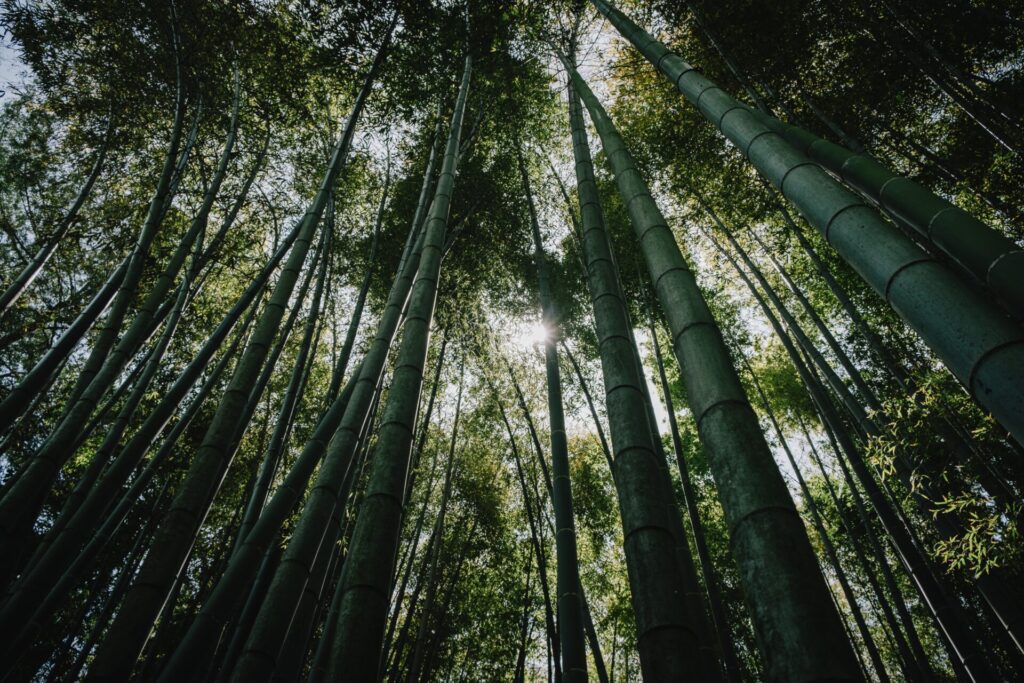
Photo Credit: Yu Kato on Unsplash
Once a Samurai City
Kamakura began as a small costal town in Kanagawa prefecture. These days, one can get there in an hour by train. Back in medieval times, it would have taken half a day on foot.
From 1185 to 1333, Kamakura was the de facto capital of Japan. It even became the nation’s most populous settlement for a time. During this period, the Minamoto clan set up their Shogunate and ruled Japan from this city after their victory over the Taira clan. The Kamakura period was a crucial time for the rise of the warrior class. And with the warrior class came the rise of Zen Buddhism, as its teachings resonated with them.
The Kamakura period came to a rather abrupt end in 1333 with the Siege of Kamakura. That battle is a story in itself (complete with a mythical parting of the seas) but it is here that Kamakura’s days as the capital came to an end. But as a city, Kamakura itself would survive and continue all the way up to the present day.
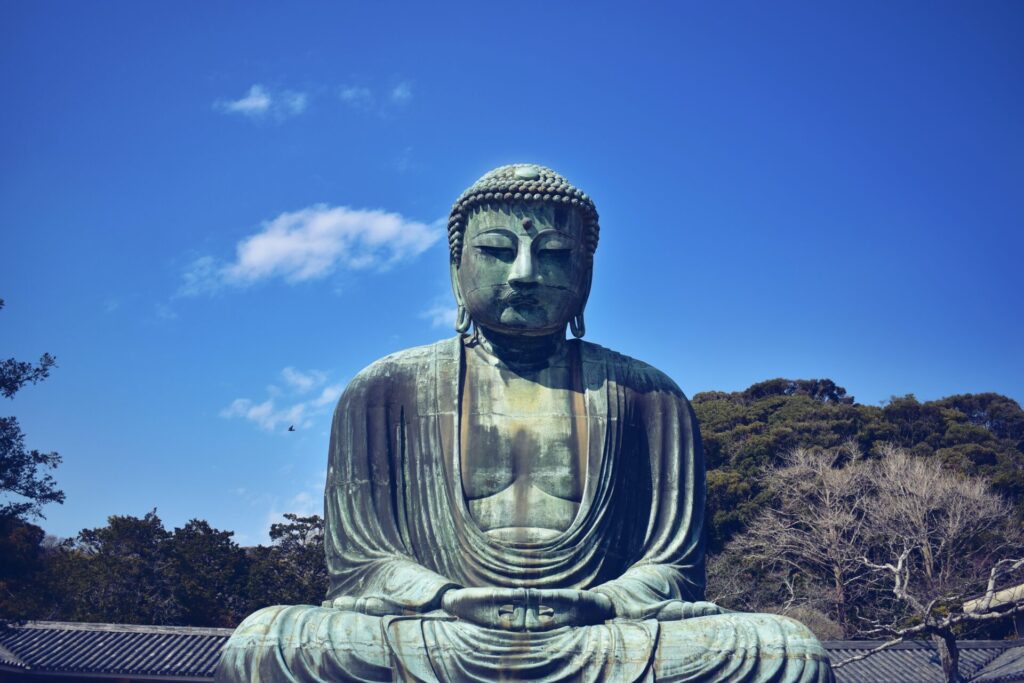
Photo Credit: Ale Sansores on Unsplash
Now a Coastal City
Today, you can still visit many of the Buddhist temples sprinkled throughout Kamakura. In one, Kotokuin temple, you can see Japan’s second largest bronze statue of the Buddha. Another temple is Hokokuji where you can see an amazing bamboo garden. There are many more shrines and temples all through Kamakura that all have unique traits of their own.
Kamakura has even more to see then just its historical buildings, though. Next to Kamakura Station is Komachi Street. It is a shopping area where a lot of tourists love to visit. There are many shops and restaurants along this road, which ends at Tsuruoka Hachimangu Temple. The entire city itself is very pleasant to walk through. Komachi Street can get a little crowded, but there are many other paths you can take. When it doubt, walk towards the sea! There you can enjoy a beautiful, peaceful view of the area as well as the beach.
Kamakura is definitely a beautiful city that I think everyone should take the time to visit. It isn’t that far from Tokyo or hard to teach. If you ever find yourself in Japan and want to see something different from one of the big cities, this is one of the nicest places to go.
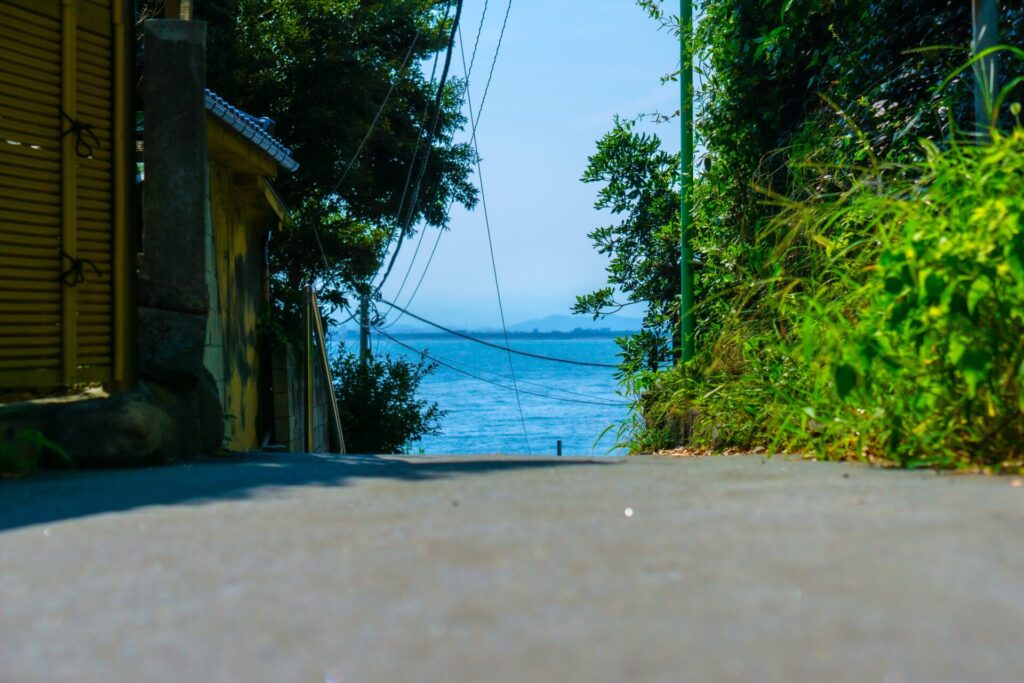
Photo Credit: natsuki on Unsplash
Photo Credits:
Top Photo: charlesdeluvio on Unsplash
2: Ale Sansores on Unsplash
All other content (text) created by the original author and © 2022 MUSUBI by Borderlink
Top Photo: Manuel Cosentino on Unsplash
Many people around the world have a dream of living or at least visiting the “Land of the Rising Sun”, or Japan. Although Japan is a small island country, it has so much to offer. From amazing views of nature, to popular anime attractions, there’s something for everyone. I would like to highlight some of those things in hopes that others can enjoy Japan as much as I have.
Tall Towers
First, I would like to introduce some of the more famous and iconic places and buildings of Japan. Of course, one of the most famous structures in Japan is Tokyo Tower. The tower is located close to the center of downtown Tokyo in Shibuya. It’s easily accessible by any public transport, and a must-see. While the tower appears red, it’s actual main color is “international orange”. Who knew!
One of the neatest things about the 333m tower is the ascent. You can take a 600-step staircase up to the observation deck. If you prefer to relax, there is also the option of taking the elevator. This still offers you a good ascending view with big glass windows. There are also parks and temples nearby which offer great spots to take photos.
Another famous building is the more recently built Tokyo Skytree. This structure is much taller, at the height of 634 meters. It features two observation decks, one at 350 meters high and another at the 450 meter mark.
Skytree is located a bit farther from the city center, but there is still plenty to do. There’s even an aquarium at the bottom of the tower! It’s also close to Asakusa, where there are many different Japanese restaurants, stores, and sometimes events. The famous Senso-ji temple features an assortments of food stalls and is something of a tourist hotspot!
Natural Wonders
Structures built by mankind can be amazing, but there are many places in Japan that feature the beauty of mother nature as well. A place well-known by people worldwide is of course, Mount Fuji.
The wonderful thing about Mount Fuji is that there’s many ways to experience it. The mountain can be seen in many parts of Japan as it stands tall in the distant horizon on a clear day. It can even be seen from the beaches of Kamakura, Kanagawa!
Another way to enjoy Mount Fuji is to climb it. I have yet to challenge this myself, but the experiences I have heard sound amazing. The 3776 meter peak can be climbed in the summer months of July and August.
There are several rest stops along the way where you can find restrooms, sleep in bunk beds or get a snack. (Tip: Bring your own snacks if you don’t want to pay for overpriced ones.) The average climb is said to be about 5 to 6 hours, so do not take this climb lightly and prepare ahead of time!
At the peak of the mountain there are several views down below and there is even a post office, so you can send some mail from the highest place in Japan.
Pop Culture
The last topic I want to discuss is one that has become world-famous in recent years. I am talking about anime of course! As the birthplace of anime and manga, there are many attractions across Japan that will satisfy any fan. One event that is not as well-known is the Cool Japan event at Universal Studios Japan (USJ).
It is an annual event usually held in the first half of each year. Anime and sometimes other things such as video game characters are featured. Since 2015 these have included the likes of “Attack on Titan”, “Lupin the Third”, “Detective Conan”, and “Neon Genesis Evangeleon”. One of the most popular exhibits was the life size titans from the manga/anime series “Attack on Titan”. Although not part of the event as of November 2021, they also have a special “Demon Slayer” ride and exhibit as well.
All the places mentioned are just a little taste of what Japan has to offer. I hope this has given you some ideas and inspiration. There’s plenty to find in the “Land of the Rising Sun”!
Photo Credits:
Top Photo: Manuel Cosentino on Unsplash
All other content (text) created by the original author and © 2022 MUSUBI by Borderlink
